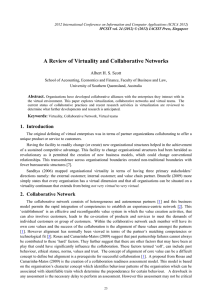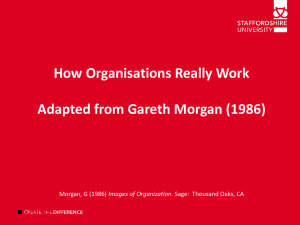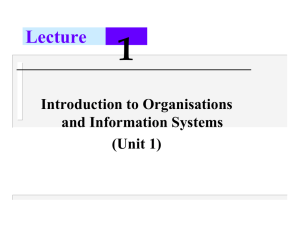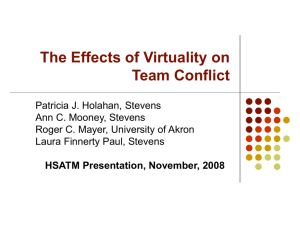The people side of virtualisation
advertisement
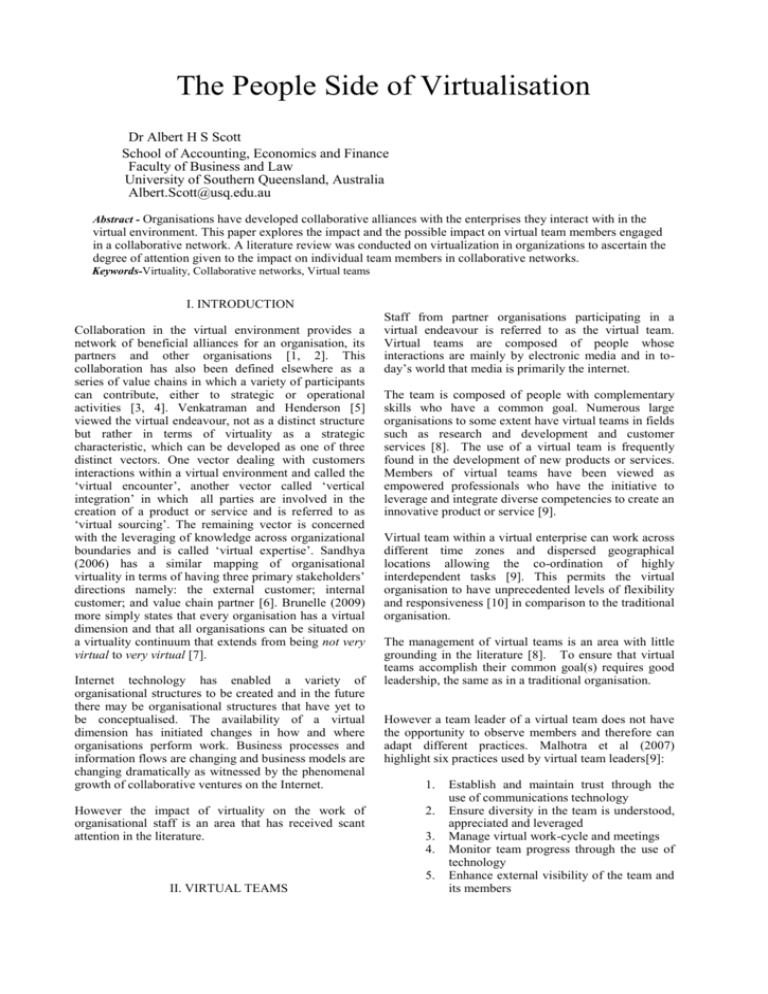
The People Side of Virtualisation Dr Albert H S Scott School of Accounting, Economics and Finance Faculty of Business and Law University of Southern Queensland, Australia Albert.Scott@usq.edu.au Abstract - Organisations have developed collaborative alliances with the enterprises they interact with in the virtual environment. This paper explores the impact and the possible impact on virtual team members engaged in a collaborative network. A literature review was conducted on virtualization in organizations to ascertain the degree of attention given to the impact on individual team members in collaborative networks. Keywords-Virtuality, Collaborative networks, Virtual teams I. INTRODUCTION Collaboration in the virtual environment provides a network of beneficial alliances for an organisation, its partners and other organisations [1, 2]. This collaboration has also been defined elsewhere as a series of value chains in which a variety of participants can contribute, either to strategic or operational activities [3, 4]. Venkatraman and Henderson [5] viewed the virtual endeavour, not as a distinct structure but rather in terms of virtuality as a strategic characteristic, which can be developed as one of three distinct vectors. One vector dealing with customers interactions within a virtual environment and called the ‘virtual encounter’, another vector called ‘vertical integration’ in which all parties are involved in the creation of a product or service and is referred to as ‘virtual sourcing’. The remaining vector is concerned with the leveraging of knowledge across organizational boundaries and is called ‘virtual expertise’. Sandhya (2006) has a similar mapping of organisational virtuality in terms of having three primary stakeholders’ directions namely: the external customer; internal customer; and value chain partner [6]. Brunelle (2009) more simply states that every organisation has a virtual dimension and that all organisations can be situated on a virtuality continuum that extends from being not very virtual to very virtual [7]. Internet technology has enabled a variety of organisational structures to be created and in the future there may be organisational structures that have yet to be conceptualised. The availability of a virtual dimension has initiated changes in how and where organisations perform work. Business processes and information flows are changing and business models are changing dramatically as witnessed by the phenomenal growth of collaborative ventures on the Internet. However the impact of virtuality on the work of organisational staff is an area that has received scant attention in the literature. Staff from partner organisations participating in a virtual endeavour is referred to as the virtual team. Virtual teams are composed of people whose interactions are mainly by electronic media and in today’s world that media is primarily the internet. The team is composed of people with complementary skills who have a common goal. Numerous large organisations to some extent have virtual teams in fields such as research and development and customer services [8]. The use of a virtual team is frequently found in the development of new products or services. Members of virtual teams have been viewed as empowered professionals who have the initiative to leverage and integrate diverse competencies to create an innovative product or service [9]. Virtual team within a virtual enterprise can work across different time zones and dispersed geographical locations allowing the co-ordination of highly interdependent tasks [9]. This permits the virtual organisation to have unprecedented levels of flexibility and responsiveness [10] in comparison to the traditional organisation. The management of virtual teams is an area with little grounding in the literature [8]. To ensure that virtual teams accomplish their common goal(s) requires good leadership, the same as in a traditional organisation. However a team leader of a virtual team does not have the opportunity to observe members and therefore can adapt different practices. Malhotra et al (2007) highlight six practices used by virtual team leaders[9]: 1. 2. 3. 4. 5. II. VIRTUAL TEAMS Establish and maintain trust through the use of communications technology Ensure diversity in the team is understood, appreciated and leveraged Manage virtual work-cycle and meetings Monitor team progress through the use of technology Enhance external visibility of the team and its members 6. Ensure individuals benefit participating in virtual teams. from These leadership practices were found conceptually to be accepted and practically applied in a study of one exemplary virtual team leader [11]. Information technology (IT) provides the communication link for virtual team members. However concern has been raised that as members are spatially diverse not only should content be communicated but also the context. This is deemed necessary to overcome the diversity of perspectives of the members which can create opportunities for misunderstandings [12]. Majchrzak et al (2005) identified eleven IT functionalities associated with support for contextualization: 1. Easily know who contributed a piece of knowledge to the team repository 2. Easily find specific entries in repositories that have been made by specific individuals 3. Easily link my team’s repository with other knowledge sources and applications 4. Easily identify historical connections between entries 5. Easily allow different people to find summaries as well as details in the repository 6. Easily interweave notes, chat, e-mail, and documents in the repository 7. Easily know rationale behind the decisions made by team members so that decisions and rationale can be revisited later 8. Easily label an entry with multiple key words it pertains to 9. Easily view annotations and comments on knowledge in team repository made by other team members 10. Be informed when knowledge in repository changes 11. Easily change identifiers on knowledge in repository as team’s ideas evolve over time It was deemed that this contextualisation was more necessary when team members were performing nonroutine work. Virtual teams have been found to be very effective as they adopt formal procedures, have structured processes and have a greater task-oriented approach [10]. Any potential for conflict tends to be lower the longer the collaboration continues [8]. III. DISCUSSION One problem identified with virtual teams is trust [13]. Kimble highlights that trust is most apparent when sharing developments where considerable effort and time may be devoted to communications. He further states that, if trust exists then team members can share their thinking, rationale and even doubts they might have about conclusions. The assessment of trust amongst partners within the virtual environment is normally performed manually in an ad-hoc manner. However the trustworthiness of partners should be thoroughly analysed in order for the collaboration to be effective [14]. Msanjila and Afsarmanesh (2009) have proposed a system that adopts multi-criteria mechanisms based on mathematical equations to create a rational assessment of the trust level of potential partners. In this system the trust aspects under consideration are classified into five perspectives, technological, social, structural, managerial, and economical and are further described in Msanjila and Afsarmanesh [15]. Trust can be impacted by the group composition and this was highlighted in a study [16]. This study shown that, in terms of level of trust, there were significant differences between homogeneous Chinese groups and heterogeneous groups of Chinese and U.S. participants. Another consideration with a virtual team is team satisfaction which is influenced by relationship conflict, familiarity, goal clarity and the preference for team work [17]. Virtual teams consist of members in different cultural settings who have feelings and emotions that determine their behaviour and practices that could influence their performance [18]. A breakdown in communications can occur because of cultural and organisational differences due to the geographical distribution of team members [19]. The identity of partners in a virtual team can be ambiguous with the absent of the normal cues we have in face-toface communications [13] Conflict in the virtual environment tends to be prevalent and leaders should try and built in resolution opportunities in the functioning of teams [17]. The dynamics of virtual teams could be modelled but there may still be undetected factors in play that affect the team dynamics [20]. The exchange of knowledge in a virtual environment is deemed to be of a greater challenge then in the traditional organisation and requires partners with different individual knowledge, skills and abilities [21]. The knowledge, skills and abilities necessary to participate in the virtual environment have not yet been clearly identified nor how they might be developed [21]. The start-up of a new virtual team requires the creation of a new organisational structure and work practices and a shared vision [19]. However Bjorn goes on to highlight that new virtual teams are prone to communications breakdowns due to failures in making sense of the organisational structure and work processes. Team effectiveness has two major dimensions, the member’s perceptions of performance and satisfaction and when there is movement to greater virtuality the traditional measures are negatively impacted [22]. Stark et highlight that although virtual teams are becoming more prevalent there is surprisingly little known about this pattern of work [17]. IV. FUTURE ANALYSIS Virtuality is still having a considerable impact on business processes and organisational structures. Developments are in hand to refine the approaches to collaborative activities of networked partners within virtual enterprises. There is a need for more systematic research that will explore the different degrees of virtuality and the possible effects on team processes. In parallel to this longitudinal studies would acknowledge the developmental aspects of virtual teams such as the reduced potential for conflict. Studies are necessary to explore what types of mechanisms could provide the experiences that would develop the necessary competence for work in the virtual environment The facility of virtuality has and will continue to enable a variety of organisational structures to be created and other structures still yet to be conceptualised. [11] [12] [13] REFERENCES [14] [1] Bauer, R.a.K.s., S.T., Measuring the degree of virtualization. Electronic Journal of Organizational Virtualness, 2003. 5(2): p. 22-46. [2] Romero, D. and A. Molina, Collaborative networked organisations and customer communities: value co-creation and coinnovation in the networking era. Production Planning & Control, 2011. 22(5/6): p. 447-472. [3] Gil-Estallo, M.D.A., et al., The New Organizational Structure and its Virtual Functioning. International Advances in Economic Research, 2000. 6(2): p. 241. [4] Travica, B., Virtual orgainization and electronic commerce. Datebase for Advances in Information Systems, 2005. 36(3): p. 4568. [5] Venkatraman, N. and J.C. Henderson, Real strategies for virtual organizing. IEEE Engineering Management Review, 1999. 27(4): p. 26-40. [6] Sandhya, S., Understanding the virtuality of virtual organizations. Leadership & Organization Development Journal, 2006. 27(6): p. 465-483. [7] Brunelle, E., Do Virtual Enterprises Exist? International Journal of e-Business Management, 2009. 3(2): p. 43-55. [8] Hertel, G., S. Geister, and U. Konradt, Managing virtual teams: A review of current empirical research. Human Resource Management Review, 2005. 15(1): p. 69-95. [9] Malhotra, A., A. Majchrzak, and B. Rosen, Leading Virtual Teams. Academy of Management Perspectives, 2007. 21(1): p. 60-70. [10] Ebrahim, N.A., S. Ahmed, and Z. Taha, Virtual Teams: a Literature Review. [15] [16] [17] [18] [19] [20] [21] Australian Journal of Basic & Applied Sciences, 2009. 3(3): p. 2653-2669. Hirschy, M.J., Virtual Team Leadership: A Case Study in Christian Higher Education. Christian Higher Education, 2011. 10(2): p. 97-111. Majchrzak, A., A. Malhotra, and R. John, Perceived Individual Collaboration KnowHow Development Through Information Technology-Enabled Contextualization: Evidence from Distributed Teams. Information Systems Research, 2005. 16(1): p. 9-27. Kimble, C., Building effective virtual teams: How to overcome the problems of trust and identity in virtual teams. Global Business & Organizational Excellence, 2011. 30(2): p. 6-15. Msanjila, S.S. and H. Afsarmanesh, On development of TrustMan system assisting configuration of temporary consortiums. International Journal of Production Research, 2009. 47(17): p. 4757-4790. Msanjila, S.S. and H. Afsarmanesh. HICI: An Approach for Identifying Trust Elements The case of technological trust perspective in VBEs. in Availability, Reliability and Security, 2007. ARES 2007. The Second International Conference on. 2007. Lowry, P.B., et al., Effects of culture, social presence, and group composition on trust in technology-supported decisionmaking groups. Information Systems Journal, 2010. 20(3): p. 297-315. Stark, E.M. and I.I.I.P.E. Bierly, An analysis of predictors of team satisfaction in product development teams with differing levels of virtualness. R&D Management, 2009. 39(5): p. 461-472. Clear, T. and S.G. MacDonell, Understanding technology use in global virtual teams: Research methodologies and methods. Information & Software Technology, 2011. 53(9): p. 994-1011. Bjørn, P. and O. Ngwenyama, Virtual team collaboration: building shared meaning, resolving breakdowns and creating translucence. Information Systems Journal, 2009. 19(3): p. 227-253. Hinds, P.J. and M. Mortensen, Understanding Conflict in Geographically Distributed Teams: The Moderating Effects of Shared Identity, Shared Context, and Spontaneous Communication. Organization Science, 2005. 16(3): p. 290-307. Wang, Y. and N. Haggerty, Knowledge transfer in virtual settings: the role of individual virtual competency. Information Systems Journal, 2009. 19(6): p. 571-593. [22] Schweitzer, L. and L. Duxbury, Conceptualizing and measuring the virtuality of teams. Information Systems Journal, 2010. 20(3): p. 267-295.
